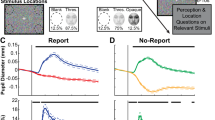Abstract
Humans have the conscious experience of 'free will': we feel we can generate our actions, and thus affect our environment. Here we used the perceived time of intentional actions and of their sensory consequences as a means to study consciousness of action. These perceived times were attracted together in conscious awareness, so that subjects perceived voluntary movements as occurring later and their sensory consequences as occurring earlier than they actually did. Comparable involuntary movements caused by magnetic brain stimulation reversed this attraction effect. We conclude that the CNS applies a specific neural mechanism to produce intentional binding of actions and their effects in conscious awareness.
This is a preview of subscription content, access via your institution
Access options
Subscribe to this journal
Receive 12 print issues and online access
$209.00 per year
only $17.42 per issue
Buy this article
- Purchase on Springer Link
- Instant access to full article PDF
Prices may be subject to local taxes which are calculated during checkout

Similar content being viewed by others
References
Libet, B., Gleason, C. A., Wright, E. W. & Pearl, D. K. Time of conscious intention to act in relation to onset of cerebral activity (readiness-potential): the unconscious initiation of a freely voluntary act. Brain 106, 623–642 (1983).
Haggard, P. & Eimer, M. On the relation between brain potentials and the awareness of voluntary movements. Exp. Brain Res. 126, 128–133 (1999).
Fink, G. R. et al. The neural consequences of conflict between intention and the senses. Brain 122, 497–512 (1999).
Blakemore, S. J., Wolpert, D. M. & Frith, C. D. Why can't you tickle yourself? Neuroreport 11, 11–16 (2000).
Daprati, E. et al. Looking for the agent: an investigation into consciousness of action and self-consciousness in schizophrenic patients. Cognition 65, 71–86 (1997).
Haggard, P. & Magno, E. Localising awareness of action with transcranial magnetic stimulation. Exp. Brain Res. 127, 102–107 (1999).
Hommel, B. The cognitive representation of action: automatic integration of perceived action effects. Psychol. Res. 59, 176–186 (1996).
Elsner, B. & Hommel, B. Effect anticipation and action control. J. Exp. Psychol. Hum. Percept. Perform. 27, 229–240 (2001).
Breitmeyer, B. Problems with the psychophysics of intention. Behav. Brain Sci. 8, 539 (1985).
Sternberg, S. & Knoll, R. L. in Attention and Performance IV (ed. S. Kornblum) 629–686 (LEA, Hillsdale, New Jersey, 1973).
Shore, D. I, Spence, C. & Klein, R. M. Visual prior entry. Psychol. Sci. 12, 205–212 (2001).
Blakemore, S. J., Frith, C. D. & Wolpert, D. M. Spatio-temporal prediction modulates the perception of self-produced stimuli. J. Cogn. Neurosci. 11, 551–559 (1999).
Reason, J. Human Error (Cambridge Univ. Press, 1990).
Frith, C. D. The Cognitive Neuropsychology of Schizophrenia (LEA, Hove, UK, 1992).
Wolpert, D. M. & Ghahramani, Z. Computational principles of movement neuroscience. Nature Neurosci. 3, 1212–1217 (2000).
Acknowledgements
This research was supported by MRC, Wellcome Trust and Leverhulme Trust. S.C. was involved in experiment 1; J.K. was involved in experiment 2.
Author information
Authors and Affiliations
Corresponding author
Ethics declarations
Competing interests
The authors declare no competing financial interests.
Rights and permissions
About this article
Cite this article
Haggard, P., Clark, S. & Kalogeras, J. Voluntary action and conscious awareness. Nat Neurosci 5, 382–385 (2002). https://doi.org/10.1038/nn827
Received:
Accepted:
Published:
Issue Date:
DOI: https://doi.org/10.1038/nn827
This article is cited by
-
Action-outcome delays modulate the temporal expansion of intended outcomes
Scientific Reports (2024)
-
When time does not matter: cultures differ in their use of temporal cues to infer agency over action effects
Psychological Research (2024)
-
Human–Swarm Interaction Simulation Platform to Assess Sense of Agency
Journal of Control, Automation and Electrical Systems (2024)
-
You do you: susceptibility of temporal binding to self-relevance
Psychological Research (2024)
-
The reliability of assistance systems modulates the sense of control and acceptability of human operators
Scientific Reports (2023)



